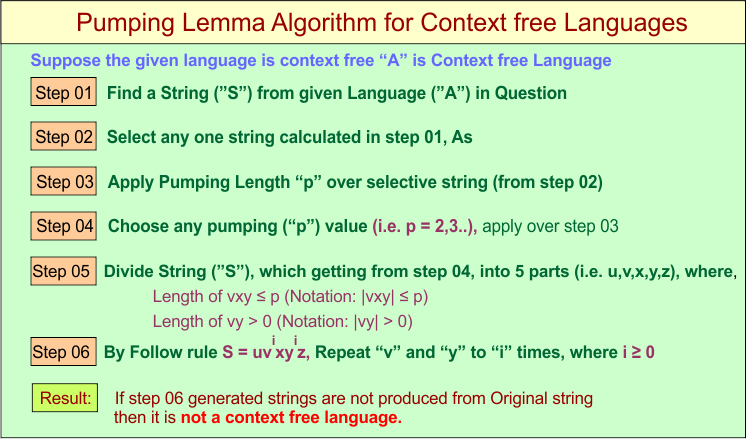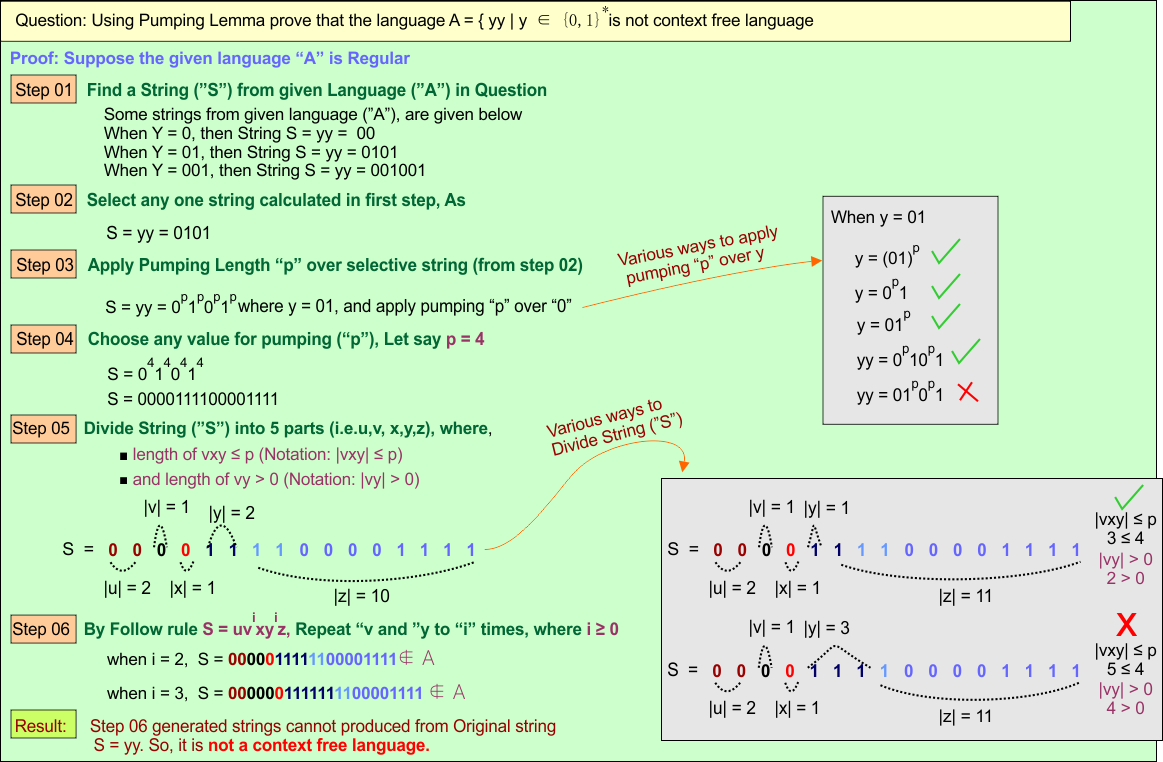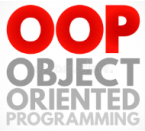Pumping Lemma for Context-Free Languages
The Pumping Lemma for Context-Free Languages (CFLs) is a fundamental property used to prove that a language is not context-free. It is similar in working to the pumping lemma for regular languages.

Conditions for Pumping Lemma in Context-Free Languages
If L is a context-free language, then there exists a constant ppp (called the pumping length) such that every string w ∈ L with ∣w∣≥p can be written as:
w = uvxyzw
such that the following conditions hold:
Condition 01: Length restriction:
∣vxy∣≤p
The length of “middle” part “vxy” sould always less than or equal to pumping “p” value.
Condition 02: Pumping parts not empty:
∣vy∣ ≥ 1
At least one of “v” or “y” is not empty. So that string can pump.
Condition 03: Closure under pumping
uvixyiz ∈ L for all i≥0
The string remains in the language for any number of repetitions (including zero).
Pumping Lemma Algorithm in Context-Free Languages
let explain the pumping lemma algorithm in context free languages

Key Differences in Context-Free vs. Regular Pumping Lemma
Here’s a clear comparison showing the key differences between the Pumping Lemma for Regular Languages and Context-Free Languages:
| Property | Regular Languages | Context-Free Languages |
|---|---|---|
| Division | w=xyzw | w=uvxyzw |
| Repeatable part | y | v and y |
| Repetition | xyiz | uvixyiz |
Pumping Lemma Examples
Example 01: Using Pumping Lemma prove that the language A = { yy | y ∈ {0,1}*is not context free language
Below is a descriptive diagram that explains that why the language A = { yy | y ∈ {0,1}* } is not a context-free language.

Step-by-step proof using the Pumping Lemma for CFLs:
Let explain again why the language A = { yy | y ∈ {0,1}* } is not a context-free language by using different values of pumping “p” and “i”.
-
Assume A is context-free.
-
Let the pumping length be p=4 (or any value ≥ 1).
-
Choose a string S=01010101 ∈ A, because this is of the form yy, where y=0101. So we can select the following string:
S=0101 0101
-
According to the pumping lemma, S can be split as:
S=uvxyz
with:
-
∣vxy∣≤p
-
∣vy∣≥1
-
uvixyiz∈A, for all i≥0
-
-
Let’s say:
-
u=0
-
v=1
-
x=0
-
y=1
-
z=0101
Then:
S = 01010101
-
-
Now pump with i=2
uv2xy2z=0110110101
-
Check the result:
-
The new string is 0110110101, which is not of the form yy (it’s not a repeat of the same string).
-
-
So, the pumped string is not in language A.
Example 02: Using Pumping Lemma prove that the language A = { anbncn | n ≥ 0 } is not a Context Free Language
Below is a descriptive diagram that explains that why the language A ={ anbncn | n ≥ 0 } is not a context-free language.
Explain: Pumping Lemma for CFLs
Let’s explain that, A = { aⁿ bⁿ cⁿ | n ≥ 1 } is not context-free by using different values of pumping “p” and “i”.
Note: By using different values of “p” and “i” as in the above diagram.
- Assume A is context-free.
- Let the pumping length be p=3 (or any value ≥ 1).
- Choose a string S=aaabbbccc ∈ A, i.e., a3b3c3.
- According to the pumping lemma rule, it can be written as:
S=uvxyz
With conditions:
- ∣vxy∣≤p
- ∣vy∣≥1
- uvixyiz ∈ A, where i≥0
Let’s say:
- u=a
- v=a
- x=a
- y=b
- z=bbccc
Then S=uvxyz=aaabbbccc, Now pump with i=2
S = uv2xy2z=aaaabbbbccc
This gives 4 a’s, 4 b’s, and 3 c’s, which is not in A. Therefore, the pumped string is not in language A.
Example 03: Using Pumping Lemma prove that the language A = { anb2n | n ≥ 0 } is not a Context Free Language
Below is a descriptive diagram that explains that why the language A ={ anb2n | n ≥ 0 } is not a context-free language.

Explain: Pumping Lemma for CFLs
Let’s explain that A = { aⁿ b²ⁿ | n ≥ 0 } is not a context-free language by using different values of pumping “p” and “i”.
Note: By using different values of “p” and “i” as in the above diagram.
- Assume A is context-free.
- Let the pumping length be p=3 (or any value ≥ 1).
- Choose a string S=a3b6=aaabbbbbb ∈ A.
- According to the pumping lemma rule, it can be written as:
S=uvxyz
With conditions:
- ∣vxy∣≤p
- ∣vy∣≥1
- uvixyiz ∈ A, where i≥0
Let’s say:
- u=a
- v=a
- x=a
- y=ε (empty, optional)
- z=bbbbbb
Then
S=uvxyz=aaabbbbbb
Now pump with i=2
S = uv2xy2z=aaaabbbbbb=a4b6
But in A, for every “a “n”, the number of b’s must be twice the number of a’s.
-
Here: 4 a’s → should have 8 b’s
-
But we have only 6 b’s → not in A














